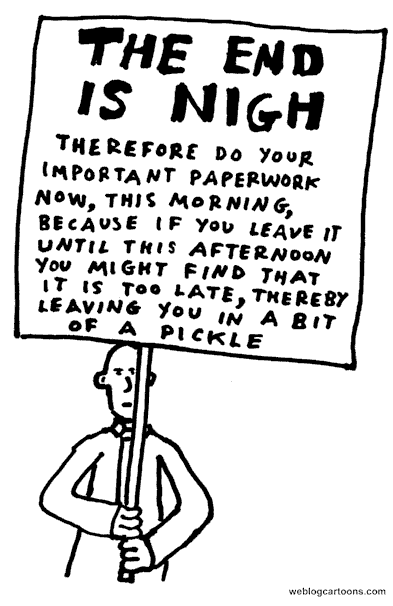When Doomsday isn’t, believers struggle to cope
Source: news.myjoyonline.com
If you’re reading this, Harold Camping’s predictions that the end of the world would start Saturday (May 21) failed to pan out.That’s good news for most of us, but Camping and his followers were looking forward to the end. After all, they believed that they were likely to be among the 200 million souls sent to live in paradise forever. So how do believers cope when their doomsday predictions fail?
It depends, said Lorenzo DiTommaso, a professor of religion at Concordia University in Montreal who studies the history of doomsday predictions.

’Consulting The Oracle’ (1884), John William Waterhouse. Priestesses sitting in a ’Temple of Prophesy’.
"If you have a strong leader, the group survives," DiTommaso told LiveScience. "Sometimes the group falls apart. Most often, the answer given by the group is that the prophecy is true, but the interpretation was wrong."
In 1994, Camping predicted a September doomsday, but hedged his bets with a question mark. On his website (familyradio.com), Camping wrote that he had misunderstood a key biblical passage, but since that time, biblical evidence for a 2011 end had "greatly solidified."
Doomsdays without doom
The classic study of "doomsdays gone bad" took place in 1954. A Chicago woman named Dorothy Martin predicted a cataclysmic flood from which a few true believers would be saved by aliens. Martin and her cult, The Seekers, gathered the night before the expected flood to await the flying saucer. Unbeknown to them, however, their group had been infiltrated by psychologist Leon Festinger, who hoped to find out what happens when the rug of people’s beliefs is pulled out from under them.
Festinger’s study, which became the basis of the book "When Prophecy Fails" (Harper-Torchbooks 1956), revealed that as the appointed time passed with no alien visitors, the group sat stunned. But a few hours before dawn, Martin suddenly received a new prophecy, stating that The Seekers had been so devout that God had called off the apocalypse. At that, the group rejoiced — and started calling newspapers to boast of what they’d done. Eventually, the group fell apart. Martin later changed her name to "Sister Thedra" and continued her prophecies.
Other failed doomsday prophets have struggled to keep their followers in line. One self-proclaimed prophet, Mariana Andrada (later known as Mariana La Loca), preached to a gang of followers in the 1880s in the San Joaquin Valley of California, predicting doomsday by 1886. But Andrada was not consistent with her predictions, and believers began to defect. Trying to keep one family from leaving, Andrada told them one of them would die on the journey. Sure enough, the family’s young son soon fell violently ill and passed away. The family accused Andrada of poisoning him. She was arrested and found not guilty, but never returned to preach to her followers.
Searching for explanations
How Camping’s followers will cope with a failed doomsday prediction depends on the structure of the group, said Steve Hassan, a counseling psychologist and cult expert who runs the online Freedom of Mind Resource Center.
"The more people have connections outside of the group, the more likely it is that they’re going to stop looking to [Camping] as the mouth of God on Earth," Hassan told LiveScience. "Information control is one of the most important features of mind control."
In his experience, Hassan said, about a third of believers become disillusioned after a failed prediction, while another third find reason to believe more strongly. The remaining group members fall somewhere in between, he said.
Doomsday groups in history have run a gamut of responses after failed predictions, said Stephen Kent, a sociologist at the University of Alberta who studies new and alternative religions. On occasion, a leader will admit he or she was wrong; other groups will come up with a face-saving explanation. Some groups may blame themselves, rationalizing that their lack of faith caused the failure, Kent told LiveScience. Other groups blame outside forces and redouble their efforts.
"One of the options is for the group to say, ’Society wasn’t ready, Jesus felt there weren’t enough people worthy of rapturing. Hence, we’ve got to go out and convert more people,’" Kent said.
After the apocalypse
Often, a failed prediction leads to splinter groups and re-entrenchment. After Baptist preacher William Miller predicted the end of the world on Oct. 22, 1844 — a date thereafter known as "The Great Disappointment" when nothing happened — his followers struggled to explain their mistake. One subset decided that on that date, Jesus had shifted his location in heaven in preparation to return to Earth. This group later became the Seventh-Day Adventist church.
Sociologists and doomsday experts agree that Camping is likely convinced of doomsday rather than perpetuating a hoax or running a scam. A con artist, Hassan said, would never set himself up for failure by giving a firm date.
A belief in doomsday gives followers a clear sense of the world and their place in it, Kent said. Those comforting beliefs are difficult to maintain after the world fails to end.
"This could be a fairly sad day for these people," Kent said. "There will be some greatly disheartened people who may be terribly confused about what didn’t happen."
Article from: news.myjoyonline.com























